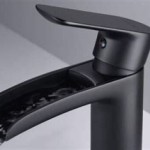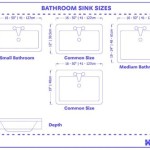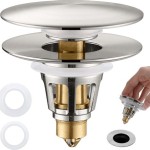How to Change a Shut-Off Valve Under a Bathroom Sink
A malfunctioning shut-off valve under a bathroom sink can lead to various issues, ranging from minor drips to significant water leaks. Addressing this problem promptly is essential to prevent water damage and maintain the integrity of the plumbing system. Replacing a faulty shut-off valve is a manageable task for many homeowners with basic plumbing knowledge and the right tools. This article provides a detailed guide on how to change a shut-off valve under a bathroom sink.
Identifying a Faulty Shut-Off Valve
Before proceeding with the replacement, accurately diagnosing the problem is paramount. A shut-off valve may need replacement for several reasons. Common indicators of a faulty shut-off valve include:
- Inability to Completely Shut Off Water: This is the most common symptom. If the valve is turned completely off, but water continues to trickle or flow through the supply line, the valve's internal components are likely worn or damaged.
- Leaks Around the Valve Stem: Water leaking from the area where the valve handle connects to the valve body suggests a worn or damaged packing nut or O-ring. While tightening the packing nut might temporarily resolve the issue, replacement is often the more reliable long-term solution.
- Corrosion: Rust or corrosion on the valve body can weaken the valve and eventually lead to leaks. Severe corrosion indicates the valve has reached the end of its lifespan and should be replaced.
- Difficulty Turning the Handle: A stiff or difficult-to-turn handle may indicate internal corrosion or mineral buildup within the valve. Forcing the handle can damage the valve and potentially shear it off, leading to a significant leak.
- Visible Damage: Cracks or other visible damage to the valve body are clear indicators of a need for replacement. Even small cracks can quickly worsen and cause a major water leak.
Gathering the Necessary Materials and Tools
Having the correct tools and materials readily available is crucial for a smooth and efficient valve replacement. The following items are typically required:
- New Shut-Off Valve: Select a replacement valve that is the same type and size as the existing one. Common types include compression valves, sweat (soldered) valves, and push-fit valves. Ensure the material (usually brass or chrome-plated brass) is compatible with the existing plumbing.
- Basin Wrench (or Adjustable Wrench): A basin wrench is specifically designed to reach and loosen the supply nuts that connect the water supply lines to the valve. An adjustable wrench can also be used, but a basin wrench provides better leverage in tight spaces.
- Adjustable Wrench (Second Wrench): A second adjustable wrench is often needed to hold the valve body while loosening the supply nuts. This prevents twisting or damaging the water supply pipes.
- Pipe Cutter (for copper pipes): If replacing a soldered valve, a pipe cutter is necessary to cut the copper pipe cleanly. A hacksaw can be used as an alternative, but a pipe cutter provides a more precise and professional cut.
- Propane Torch and Soldering Supplies (for copper pipes): If installing a new soldered valve, a propane torch, soldering flux, solder, and heat-resistant gloves are required.
- Compression Fittings (for compression valves): When using compression valves, ensure that new compression rings (ferrules) and nuts are used for a secure and leak-proof connection.
- Push-Fit Connector Removal Tool (for push-fit valves): For removing push-fit valves, a specialized removal tool is needed to release the valve from the pipe.
- Bucket and Towels: Have a bucket and towels on hand to catch any residual water in the pipes and to clean up spills.
- Plumber's Tape (Teflon Tape): Plumber's tape is used to seal threaded connections and prevent leaks.
- Safety Glasses: Always wear safety glasses to protect the eyes from debris or splashing water.
- Gloves: Gloves protect the hands from dirt, grime, and sharp edges.
- Flashlight or Headlamp: Good lighting is essential for working in the often-dark and confined space under a sink.
- Plumbing Snake (Optional): If the water flow is significantly reduced even with the shut-off valve removed, a plumbing snake may be needed to clear any blockages in the water supply line.
Step-by-Step Procedure for Replacing the Shut-Off Valve
Following a structured procedure ensures the valve replacement is performed correctly and safely.
- Turn Off the Main Water Supply: The most critical step is to turn off the main water supply to the house to prevent flooding. The main shut-off valve is typically located in the basement, near the water meter, or outside the house in an underground box. Once the main water supply is turned off, open the lowest faucet in the house (usually in the basement or first floor) to relieve pressure in the plumbing system.
- Isolate the Sink's Water Supply Lines: If the main water supply valve is inaccessible or difficult to operate, attempt to locate shut-off valves for the bathroom. These are located near the water meter/water supply for the house. If these valves are not present or dysfunctional, the main water supply must be turned off.
- Disconnect the Water Supply Lines from the Existing Valve: Place a bucket under the sink to catch any remaining water. Using a basin wrench or adjustable wrench, carefully loosen the nuts connecting the water supply lines to the existing shut-off valve. Start with the supply line that connects the valve to the faucet, then disconnect the supply line that connects the valve to the water supply pipe. Be prepared for some water to spill out.
- Remove the Old Shut-Off Valve: Once the supply lines are disconnected, remove the old shut-off valve. Depending on the type of valve, this may involve unscrewing a compression nut, unsoldering the valve from the copper pipe, or using a removal tool for a push-fit valve.
- Prepare the Water Supply Pipe: The preparation steps depend on the type of replacement valve being installed.
- For Compression Valves: Clean the end of the water supply pipe with fine-grit sandpaper or emery cloth to remove any corrosion or debris. Ensure the pipe is smooth and free of burrs.
- For Solder Valves: Clean the end of the copper pipe thoroughly with sandpaper or emery cloth. Apply soldering flux to the outside of the pipe and the inside of the new valve fitting.
- For Push-Fit Valves: Ensure the end of the pipe is clean, smooth, and free of any sharp edges. A pipe cutter is recommended for a clean, square cut.
- Install the New Shut-Off Valve: Again, the installation method depends on the type of valve.
- Compression Valve: Slide the compression nut and then the compression ring (ferrule) onto the water supply pipe. Insert the pipe into the valve fitting and tighten the compression nut with an adjustable wrench. Overtightening can damage the compression ring and cause leaks, so tighten until snug.
- Solder Valve: Slide the new valve onto the prepared copper pipe. Heat the fitting with a propane torch until the flux begins to bubble. Apply solder to the joint, allowing it to melt and flow into the gap between the pipe and the fitting. Remove the torch and allow the joint to cool completely.
- Push-Fit Valve: Simply push the valve onto the prepared pipe until it clicks into place. Ensure that the valve is fully seated on the pipe.
- Reconnect the Water Supply Lines: Reconnect the water supply lines to the new shut-off valve. Ensure that the connections are tight but not overtightened. Use plumber's tape on the threads of the supply line fittings to ensure a leak-proof seal.
- Turn on the Water Supply and Check for Leaks: Slowly turn on the main water supply valve. Carefully inspect all connections around the new shut-off valve and the water supply lines for any leaks. If leaks are present, tighten the connections slightly. If leaks persist, disassemble the connection, inspect the components, and reassemble with fresh plumber's tape or a new compression ring.
- Test the New Shut-Off Valve: Turn the new shut-off valve on and off several times to ensure it functions properly and completely shuts off the water flow. Check for leaks again while the valve is in both the open and closed positions.
- Clean Up: Remove the bucket and towels, and clean up any spills. Dispose of the old shut-off valve and any used plumbing materials appropriately.
Following these steps will allow for the replacement of a faulty shut-off valve under a bathroom sink and prevent further water damage.

How To Install Water Shut Off Valve For Sinks

How To Replace A Leaking Shutoff Valve Under Sink

How To Replace A Shut Off Valve Under Your Sink

Handle Broke Off On Shut Valve Under Sink Diy Plumbing Repair Bathroom

How To Replace Shutoff Valve Under Bathroom Sink

How To Replace A Shutoff Valve Diy Family Handyman

How To Install A New Bathroom Water Supply Shutoff Valve

Replace Bathroom Sink Shut Off Valve

How To Replace A Flowtite Push Pull Valve With Standard Shut Off For Dishwasher

Install Shut Off Valve Under Sink Replace Faucet Mobile Home Repair
Related Posts







